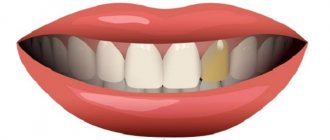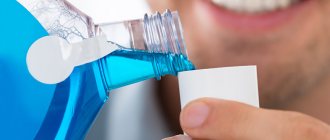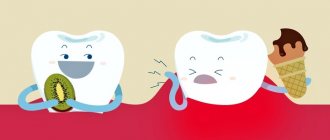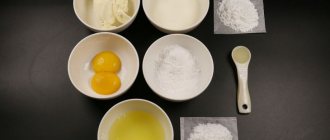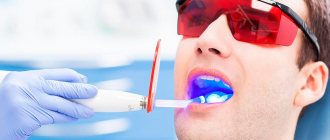Have you had your teeth whitened and your doctor recommends following a white diet? Do you want to know the exact checklist of foods that, according to dentists’ recommendations, should not be consumed on a white diet. What can replace products with coloring pigments? Experts told us about this and much more.
The white diet is a special type of diet in which a person consumes non-coloring foods, that is, without pronounced pigment. The so-called transparent diet is prescribed after teeth whitening. A colorless diet is recommended for patients to consolidate the effect, preserve the resulting color of tooth enamel for as long as possible, and protect from exposure to various substances. Also, a white diet should be followed when whitening at home.
Clinical case with a transparent diet: the patient planned home teeth whitening. I purchased special products from the dentist (mouth guards with gel) and consulted with a dentist. It is recommended to adhere to a colorless diet throughout the entire whitening period (about a week), as well as for another 7–10 days after the end of the course.
Following a colorless diet is important not only for maintaining the effect of the procedure. You should not subject additional tests to tooth enamel, which is somehow weakened after whitening procedures and has a porous structure. In two to three weeks of the white diet, the enamel will be restored, and you will be able to return to your usual lifestyle, but with certain nuances in the pigment content of the products.
How strictly should you follow the white diet?
As much as possible with a diet. For example, in order for the effect to last for a long time, when on a white diet, you should avoid foods with coloring pigments for 2 to 3 weeks after the procedure.
Also, as part of the white diet, experts advise gradually introducing useful habits: partially or completely giving up red wine, coffee or black tea, drinking colored drinks through a straw, replacing the same tea with kefir or milk.
Remember! Pigment substances are not harmful to healthy tooth enamel, but in the presence of inevitable microdamages after bleaching, dyes can penetrate deep into it and stain it.
The most important thing in the white diet is to pay attention to the color of the foods. The diet has no strict restrictions on the quantity or variety of food products.
Dentistry for those who love to smile
+7
Make an appointment
What foods stain teeth?
- Coffee
. Lovers of this drink most often have a yellow or brownish coating on their teeth. This is due to the cocoa butter, heavy carbohydrates and sugars contained in coffee. Instant coffee has a greater effect on dental health than ground coffee.
enamel. You can reduce the effect of coffee on your teeth by diluting it with milk or water. It is also best to limit your coffee intake to one cup per day. - Tea
. Contains tannins and, like coffee, stains teeth a yellowish-brown tint. Tea in bags is most harmful to teeth: due to the artificial components contained in it, which happens very often, it stains teeth more than leaf tea. The type of tea - green or black - does not matter. - Wine
. White wine contains acids that negatively affect tooth enamel, causing microcracks to appear through which coloring substances penetrate deeper. Red wine contains tannins and a burgundy-red tint, which also contributes to tooth staining. - Carbonated drinks
. Not only do they change the color of your teeth, but they can also leach calcium from your teeth. In addition to a huge amount of sugar, they contain malic, citric and other acids that literally “corrode” the enamel. You should especially beware of colored soda - it not only corrodes the enamel, but can also stain the tongue and teeth in poisonous colors. If you decide to drink Coca-Cola, do it through a straw, this will reduce the harmful effects on your teeth. - Juices
. Bright and dark juices, such as pomegranate, cranberry, grapefruit, etc., due to their bright color, can also cause yellowing of teeth. It is healthier to simply eat fruit or drink juice diluted with water. - Vegetables and fruits
. Berries that are rich and dark in color, such as blueberries, blackberries, blueberries, cherries, and cranberries, can cause staining and yellowing of teeth. Among vegetables, beets are a strong dye due to the high content of chromogens in them. To prevent dark plaque from forming on your teeth, it is recommended to brush your teeth immediately after eating beets. - Sauces and seasonings
. Many seasonings that have a yellow or brown tint are also on the list of foods that stain teeth. Due to their bright color and high acid content, tomato-based sauces are harmful to teeth. Also, do not overuse soy sauce. - Chocolate and ice cream
. Chocolate and caramel from their color also lead to darkening of the enamel. As for ice cream, sweet and fruit desserts, they contain artificial food colors and chemical components that lead to microtrauma and staining of teeth.
To avoid staining and maintain the natural color and health of your teeth, we recommend visiting a dentist once every 6 months for professional oral hygiene.
You can make an appointment by phone. 8(863)2098902.
What exactly is not recommended to eat on a white diet? Stop list of products
The white diet excludes the following foods from the diet:
- black and green tea. By the way, it is green tea that causes plaque to form on teeth extremely quickly. This product should also be excluded from the white diet so that your teeth do not darken after whitening;
- bright sauces: tomato, soy, adjika, ketchup, etc.;
- coffee, cocoa are obvious stop drinks of a transparent diet;
- colored fruits: plums, dark grapes, red apples;
- fruit and vegetable juices, compote, fruit drink;
- chocolate, lollipops, dragees;
- citrus;
- jam;
- egg yolk;
- red wine.
Products that you can eat
After such an impressive list of prohibitions, the question arises: what can you eat without fear?
In fact, there are not as few permitted products as it might seem at first glance:
- Dairy products – natural kefir, cottage cheese, yogurt without dyes
- Cheeses
- Fruits: green and yellow apples, pears, white grapes, bananas
- Vegetables: cauliflower and white cabbage, celery, cucumbers, mushrooms, beans
- White meat, fish, seafood, eggs
- White wine is acceptable for alcoholic drinks
- Sweets – white marshmallows, marshmallows, white ice cream
Let's summarize the above:
Following a transparent diet in the first 7-10 days after the whitening procedure will protect the new white color of the enamel from external coloring pigments and allow the result to consolidate. A snow-white smile – isn’t this a worthy reward for such a short restrictive period?
In the future, try to limit the intake of coloring products that contribute to the appearance of unwanted pigmentation of the enamel. Of course, it is impossible to eliminate the entire list of listed undesirable foods from our diet forever, but it would not hurt to make a rule - if you have eaten or drunk any drink from the “prohibited list,” then you need to brush your teeth with a brush and toothpaste as soon as possible, or better yet. immediately after eating.
If you DO NOT like the temporary effect of whitening, you DO NOT want to repeat the procedure every 1-2 years and comply with such restrictions, the best solution would be to install veneers or ultraneers. For a bright, beautiful smile, you will need to install at least 6 veneers on the upper jaw.
What happens if you break the rule of the white diet?
Nothing catastrophic, but the effect of teeth whitening will no longer be the most ideal. Firstly, a thin film of pigment deposits will do its job - the color will darken. Secondly, if the diet requirements are violated, the very shine and sparkle of the enamel will disappear, for which many patients love whitening so much. Thirdly, the patient himself will see the difference in his teeth, and he will be offended that, for the sake of a moment of weakness or inattention, he ruined the aesthetics of a perfect smile. There is also a risk of tooth decay or inflammatory gum disease.
Coffee
Aggressive dyes contained in coffee, especially instant coffee, easily stain teeth. And much stronger than tobacco smoke. In addition, coffee can provoke the formation of yellow plaque, as it contains heavy carbohydrates and cocoa butter, not to mention sugar.
Startsmile tip:
To reduce the coloring effect, drink coffee with milk.
Allowed products after the procedure
In addition to your favorite treats and drinks that require exclusion for up to 3 weeks, there are healthy foods:
- The meat is fatty and dietary. Steamed cutlets, goulash, and stewed cabbage rolls are suitable.
- Garnish with mashed potatoes, rice, oatmeal, pasta.
- Soups and meat broths of different consistencies.
- From fermented milk products: sour cream, yogurt without dyes, non-sour cottage cheese, milk.
- Fruits that do not leave a tint, vegetables without acid - zucchini, white cabbage and beans, potatoes.
- Still drinks, diluted juice.
- Bread of any kind, without a hard crust.
- Soft confectionery products: pastries, cakes, marmalade, marshmallows.
- Eggs are allowed in any type of preparation.
Monitor the temperature of the prepared foods; they must be warm when eaten.
Berries
The rich color of the pulp and skin of blueberries, blueberries, black currants, cherries, cranberries, grapes, blackberries and raspberries stains teeth, giving them the characteristic shade inherent in berries.
Startsmile tip:
Berries are very good for health, so you shouldn’t give them up. Rinsing your mouth after eating with a special whitening rinse will help neutralize the effect of coloring pigments.
Maintaining the whitening effect
Do not forget about general recommendations for oral care, namely:
- Visit your dentist regularly.
- Take care of your teeth. There are special devices for cracking nuts.
- Get rid of bruxism (creaking at night). This habit leads to thinning and the formation of microcracks.
- Don't forget to floss after every meal.
These are only general recommendations that lead to damage to the integrity of the enamel and discoloration. All people have teeth, and caring for them today has become a cultural tradition, and not just a tribute to fashion and external beauty.
Causes of bad breath - even brushing your teeth does not give noticeable freshness
An unpleasant odor from the oral cavity involuntarily creates discomfort during communication. This is facilitated by:
- Interdental deposits.
- Unskilled treatment of the space under the gums by insufficiently experienced dentists.
- Poorly cleaned dental plates or faster than necessary for hygiene requirements. Then plaque gets clogged in the gum pockets, which threatens periodontal disease and further tooth decay.
- It is in vain that some patients expect that laser removal of stones will permanently eliminate dental problems. This is a misconception - you need to take care of your teeth and the interdental space with the same zeal.
- When going to work, school, or guests, refrain from spicy foods - fish, onions, garlic.
- Bad breath occurs due to diseases of the gastrointestinal tract, kidneys and liver.
- Promotes the proliferation of harmful microbes, not least tonsillitis, sinusitis, and diabetes.
- Taking certain medications can contribute to bad breath.
If the odor persists after professional treatment of the dental surface, contact your dentist for advice. The tooth may need to be removed and a new one installed.
What causes the color to change
Discoloration of enamel occurs as a result of thinning of its top layer, which leads to exposure of pores. This situation contributes to the unhindered penetration of chromogens into them - organic pigments contained in products.
Often the cause of enlarged pores is the use of products containing acids, which help loosen the enamel.
Thinning enamel occurs in people of all ages. In adults, changes in dental tissue can be age-related; in young people, they can be caused by frequent consumption of acid-containing drinks or foods.
Are sports drinks bad for your teeth?
Sugary drinks are not good for your teeth at all. Other, acidic drinks, such as lemonade, can erode enamel over time. Long-term use of such drinks makes teeth more susceptible to substances that corrode enamel.
If you allow yourself to drink these drinks, then you should also remember the rule for cleaning a stain from a T-shirt: rinse with water and brush to reduce or stop staining.
On the subject: Habits that destroy teeth
Back to contents
Prohibited products after cleaning the stone
Products with dyes, sour and hard products are strictly excluded. Professional hygiene requires limiting the following range of products:
- black tea and coffee, hot chocolate and cocoa, fruit juice, compote and carbonated drinks;
- sour first courses (tomato soup and borscht, beetroot soup);
- buckwheat;
- black bread;
- fruits with bright juice, these include: currants, strawberries, mulberries, raspberries, pomegranates, cherries;
- sour citrus fruits;
- sauces, vinegar and mustard are added to them;
- dark chocolate, jam, colored sweets.
Acidic, sticky and viscous substances prevent the enamel and gums from recovering after hygiene procedures during the prescribed period.
What determines the color of enamel
Natural color consists of two components. The first is enamel - it is considered one of the most durable tissues and is responsible for protecting teeth from damage, but to a much lesser extent for color.
If the enamel is intact and sufficiently mineralized (normally it consists of 97% inorganic substances), it refracts light waves and teeth appear whiter.
If, for various reasons, the enamel becomes thin, the color of the main tooth tissue - dentin - shines through it. It consists of two-thirds salts, mainly calcium and phosphorus, organic substances, and water, which makes it opaque.
Dentin color, the second component of tooth color, is caused by yellow-brown pigments.
Discoloration can be caused by both changes in the microporous structure of the enamel and changes in the composition of dentin.
In natural conditions, perfectly white teeth are not found. Dentists determine color using the Vita scale, consisting of 16 shades, and identify quite a few factors that influence this indicator. The main ones are the following:
- Genetically determined. Structure and color are hereditary factors and also depend on race.
- The presence of systemic diseases accompanied by darkening or discoloration (Addison's disease, jaundice, hypoparathyroidism, hypothyroidism, some infectious diseases).
- The state of the enamel-dentin junction of the tooth , which directly affects the optical properties.
- Inevitable age-related changes , directly related to a decrease in the body’s ability to recover, including bone tissue.
- Exposure to external factors , namely drugs and food products of organic origin containing chromophore groups in molecules (for example, pigments).
The most interesting are the possibilities of minimizing the impact of external factors on teeth, which is the focus of this article.
Read about how to restore tooth enamel at home. We offer here reviews of Rox Active Calcium toothpaste.
At this address https://dentist-pro.ru/krasota-i-uxod/otbelivanie/domashnee/zubov-perekisyu-vodoroda-plyusy-i-minusy-sposoby-otzyvy.html we will talk about teeth whitening using hydrogen peroxide.
Lollipops and candies
If candy, chewing gum or ice cream stains your tongue, you can be sure that your teeth will too.
Startsmile tip:
Choose chewing gum that is sugar-free and sweet without artificial colors. To effectively fight bacteria, it is also recommended to use an ultrasonic toothbrush and an oral irrigator. The device significantly improves the quality of oral hygiene and has a beneficial effect on soft tissues. From a wide range of models, it is not easy to understand which irrigator is best to choose, however, you can find a device that is suitable in terms of functionality and price.
Preventing tea stains on teeth
Tea lovers need to use a special whitening paste. A good option is to purchase ASEPTA PLUS, which provides gentle whitening and protection against plaque formation and unwanted pigmentation.
Advantages of ASEPTA PLUS paste:
- a unique multi-stage cleaning system that does not damage the enamel;
- content of potassium citrate and hydroxyapatite, which mineralize weakened enamel.
- calamus and eleutherococcus extracts strengthen the gums and help maintain healthy mucous membranes;
- Possibility of daily use.
Practical advice
If you cannot deny yourself the pleasure of eating your favorite foods, then you will be interested in several practical tips that reduce the risk of developing tooth discoloration:
- Do not drink coffee and tea too hot, do not alternate with cold water. Changes in heat and cold are no less destructive to enamel than the development of plaque.
- Minimize the consumption of bright berries (blackberries, blueberries), replacing them with lighter ones (apples, melons, grapefruits). You should not abuse juices, especially not freshly squeezed ones. Play it safe by rinsing your mouth.
- Be careful when consuming carbonated liquids. If you can't resist sweet carbonated drinks, use a straw. It's simple, effective, and does not harm the enamel.
- Less sugar is the motto of the modern generation. Eliminate candies like toffee and those containing unnatural dyes from your diet. It definitely won't get any worse.
- When consuming sauces and bright spices, we can recommend combining them with broccoli and lettuce, which will minimize the harm caused.
In addition, it is necessary to remember that products that stain teeth should not remain in the oral cavity for a long time. After drinking a drink or product containing pigmented particles, it is advisable to rinse your mouth.
Important! It is not recommended to brush your teeth within half an hour after eating food. During the period of eating food, a low pH (acidic) environment is created in the mouth to activate the enzymes of the digestive system.
The other side of such an environment is the softening of the enamel. Additional mechanical stress can lead to destruction of the enamel.
The video provides additional information about foods that are harmful to teeth.

